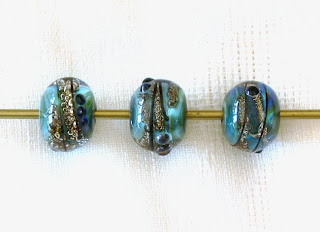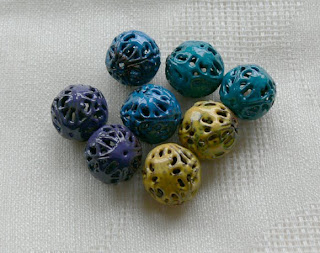Lunedi, Feb 22
Well, that was a quick week!
Watched a lot of curling on the tv ... I think the winter olympics are so much more exciting than the summer ones. Speed skating, luge, slaloms, figure skating, snowboarding cross ... it's hard to sit still when these are on. I think I'd like to try curling... probably in my genes. Hmmm, there is a curling club over in Nashua....
Made some more of the champagne beads... almost all of the pretty blue-green ones I made have cracked. It's so sad when a bead that you have oh-so-carefully made comes out of the kiln cracked, or worse five of them. Can't do anything with them - except mourn for the time lost and the expensive glass wasted. I know, I know... think of the wonderful learning experience! Sometimes that just isn't adequate compensation.
Enameled on some more metal ... brass objects seem to work the best as a base for torch enameling. Even the fairly fine filigree seems to hold up better than copper or steel wire - both of which I rather handily melted while trying to enamel. I can't quite figure out why hammered thicker copper would melt faster than very thin brass. The melting points of copper and brass are similar... 1981F and 1910F respectively. Though, according to Tim McCreight (the Complete Metalsmith) brass comes in alpha and beta alloys - alpha < 36% zinc and beta > 36% zinc. I must have beta brass (it's better for hot working).
It's very hard to find out the composition of metals when you go shopping these days. I would say that most of the available metal beads and findings are not marked with information more than it is composed of "base" metal. That, apparently, means not made of a precious metal such as gold, silver, or platinum. I have come to expect that if I buy some of these - let's say - beads, I could expect that it would be cheap, or inexpensive if you prefer, often not terribly well designed or crafted, and I would develop some sort of skin discoloring or rash from it. That doesn't really narrow down what kind of metal it is made of, but I won't be putting it in a torch flame at any rate.
Even shopping at a well know DIY home improvement store, it is really hard to find out what the tools are made of. It is important to me that the tools I buy are stainless steel, which won't readily melt in a torch flame. Rarely are the product materials marked. As if it didn't matter.
During the course of the enameling day I did learn a lot about pennies. More than I knew existed. More than you or I are probably interested in knowing, even. The short version is that the last completely copper penny was minted in the 1800's and is known as a large penny. And I actually do have one ... somewhere. The pennies made after 1962 have a great deal of zinc (like 97% zinc and clad in 2.65% copper) in them and burn up faster than my toaster can burn toast!
Instant mess! And probably pretty toxic too... the zinc, not necessarily the toast...but I wouldn't want to eat it. Good thing I have great fan/exhaust system in my torching booth, huh?
I wonder what this week will bring?
Watched a lot of curling on the tv ... I think the winter olympics are so much more exciting than the summer ones. Speed skating, luge, slaloms, figure skating, snowboarding cross ... it's hard to sit still when these are on. I think I'd like to try curling... probably in my genes. Hmmm, there is a curling club over in Nashua....
Made some more of the champagne beads... almost all of the pretty blue-green ones I made have cracked. It's so sad when a bead that you have oh-so-carefully made comes out of the kiln cracked, or worse five of them. Can't do anything with them - except mourn for the time lost and the expensive glass wasted. I know, I know... think of the wonderful learning experience! Sometimes that just isn't adequate compensation.
the bead on the right is cracked, but it doesn't show in the picture
Enameled on some more metal ... brass objects seem to work the best as a base for torch enameling. Even the fairly fine filigree seems to hold up better than copper or steel wire - both of which I rather handily melted while trying to enamel. I can't quite figure out why hammered thicker copper would melt faster than very thin brass. The melting points of copper and brass are similar... 1981F and 1910F respectively. Though, according to Tim McCreight (the Complete Metalsmith) brass comes in alpha and beta alloys - alpha < 36% zinc and beta > 36% zinc. I must have beta brass (it's better for hot working).
the good result...
the less successful result
It's very hard to find out the composition of metals when you go shopping these days. I would say that most of the available metal beads and findings are not marked with information more than it is composed of "base" metal. That, apparently, means not made of a precious metal such as gold, silver, or platinum. I have come to expect that if I buy some of these - let's say - beads, I could expect that it would be cheap, or inexpensive if you prefer, often not terribly well designed or crafted, and I would develop some sort of skin discoloring or rash from it. That doesn't really narrow down what kind of metal it is made of, but I won't be putting it in a torch flame at any rate.
Even shopping at a well know DIY home improvement store, it is really hard to find out what the tools are made of. It is important to me that the tools I buy are stainless steel, which won't readily melt in a torch flame. Rarely are the product materials marked. As if it didn't matter.
During the course of the enameling day I did learn a lot about pennies. More than I knew existed. More than you or I are probably interested in knowing, even. The short version is that the last completely copper penny was minted in the 1800's and is known as a large penny. And I actually do have one ... somewhere. The pennies made after 1962 have a great deal of zinc (like 97% zinc and clad in 2.65% copper) in them and burn up faster than my toaster can burn toast!
totally and utterly toasted
Instant mess! And probably pretty toxic too... the zinc, not necessarily the toast...but I wouldn't want to eat it. Good thing I have great fan/exhaust system in my torching booth, huh?
I wonder what this week will bring?





Comments
Post a Comment